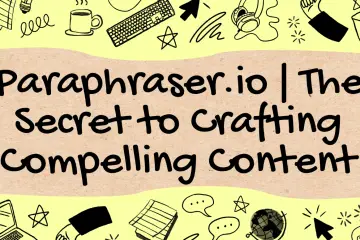Do you know what the writer’s primary purpose for writing an article is? All kinds of literature can be found in the world, from Shakespeare’s classic works to the script ideas that impacted this summer’s biggest blockbusters. It doesn’t matter how different these works are in terms of their tone, gender, or style; they all have one thing in common: a goal.
The author’s intention
For a variety of reasons, writers put pen to paper. These motives are referred to as the “purpose” of the author. Authors can select from a wide range of writing formats, genres, and dialects, depending on the project’s goals. The acronym PIE, which stands for persuade, inform, and entertain, is a concise way to encapsulate the author’s key goals. Although there are numerous motives for writing, the three most common are to persuade, inform, and entertain. These three basic classifications apply to the majority of other issues. EssayHub can also help you write an essay by sharing their expertise and know-how.
Types of Author’s Purposes in Writing an Article
To inform
The primary goal of writing an article to inform is to provide information and knowledge to the reader. This type of article aims to educate and raise awareness on a specific topic or issue. The author provides relevant data, statistics, and facts to support their arguments and help the reader understand the topic.
To persuade
The purpose of writing an article to persuade is to convince the reader to take a particular action or adopt a specific viewpoint. This type of article is often written to influence public opinion or promote a cause. The author presents arguments, evidence, and counterarguments to support their position and influence the reader’s decision-making process.
The primary goal of an author is often to persuade. If you’re writing to persuade, you’re attempting to get your reader to agree with you. This could imply that the author wishes to influence the reader’s behavior. This style of writing is a lot more prevalent than you might think. Persuasive writing is any text that attempts to persuade the reader to adopt a particular point of view or take some sort of action.
Of course, the author communicates his or her own views in this style of writing but also provides facts and instances to support those views. The author’s opinion is bolstered by this knowledge, which encourages readers to agree with it. Speeches, advertising, and newspaper articles are all instances of persuasive writing. There are numerous examples of propaganda articles that have been written in order to persuade. Think about how the author intends you to feel or act after looking at the image below.
To entertain
Writing an article to entertain means to create a piece of content that is meant to be enjoyable and entertaining for the reader. This type of article may include humor, stories, anecdotes, or other elements that aim to engage and entertain the reader. The author focuses on providing an enjoyable reading experience and entertaining the reader, rather than providing information or persuading them.
To express personal opinions or ideas
Some authors write articles to express their personal opinions or ideas on a particular subject. This type of article may be written as a personal essay, opinion piece, or editorial. The author’s goal is to express their thoughts, beliefs, and ideas on a specific topic and share their perspective with the reader.
To educate or teach
An article written to educate or teach aims to impart knowledge or skills to the reader. The author focuses on breaking down complex concepts and explaining them in a clear and concise manner. The article is written in a way that makes it easy for the reader to understand and apply the information they have learned.
To sell or promote a product or service
Some authors write articles to promote a product or service they are selling. This type of article may take the form of an advertisement, product review, or promotional article. The author’s goal is to inform the reader about the product or service and convince them to make a purchase.
To inspire or motivate
An article written to inspire or motivate aims to encourage the reader to take action, pursue their goals, or make positive changes in their life. The author shares personal stories, experiences, and insights to motivate and inspire the reader. The goal is to create a positive impact and encourage the reader to achieve their dreams and aspirations.
Also Read: BEST GAMING CHAIR FOR XBOX ONE
Reports
The second type of author’s goal is to educate the reader. It is the author’s goal to educate the reader about real-world topics by providing facts about them. On the other hand, these facts aren’t employed to support any particular point of view, unlike pieces meant to persuade. To educate the reader, the facts are laid out. Informational texts include textbooks, cookbooks, newspaper articles, and encyclopedias.
In order to help the reader, all of these forms have been written. Authors often promote their works as informational texts, but they frequently include their own personal ideas. As a reader, make sure you are prepared to hide information as information in order to better understand the content. Even if some publications profess to just publish the facts, closer scrutiny reveals that they are attempting to convince you into believing a particular viewpoint. ۔ Keep an eye out for these tidbits of wisdom.
Entertainment
The ultimate purpose of the author is to amuse. Almost everything you associate with the term “literary” may be found here. Authors that write for the sheer joy of it do so in order to convey a tale about people, places, and events, whether those are genuine or made-up. All fictional works of literature are included in this category.
There are a variety of forms of enjoyment that can be found in the written word. This type of fiction literature includes Harry Potter, The Hunger Games Trilogy, The Diary of a Vampire Kid’s volumes, and many others. Because of this, these books have become so popular. These articles pique the interest of readers. A lot of sequels, movies, and even TV shows are created because they don’t gain anything it.
The purpose of the multi-author
Nonfiction works that fall into more than one category are known as “multi-category works.” If an autobiography or biography is based on real-life events and individuals, then you may presume that it is an example of a piece of reporting writing. Some people, on the other hand, find great enjoyment in hearing about people’s real-life experiences. So for them, we have the BEST ZERO GRAVITY CHAIR An autobiography or a biography might be provided for both amusement and education in this way.
Research-based article
For more than a decade, I honed my writing skills as a high school English teacher. It is possible to learn and use a writing formula. Anyone can learn how to write a well-supported article with a lot of practice. In essence, every piece of writing has a central theme behind it. The author’s goal is to accept the reader’s claim.
To persuade a reader, you must provide them with solid evidence. Statistics, statistics, well-known specialists, and/or peer-reviewed studies are all used to back up the author’s claims in this study piece. The author’s point should be backed up by evidence, and the author’s insights should be supported by evidence. These are only a few examples of goal-setting shareware.
How to Determine the Author’s Purpose
Understanding the tone of the article: The tone of an article can reveal a lot about the author’s purpose. For example, if the tone is serious and informative, it may indicate that the author’s purpose is to inform. Conversely, if the tone is persuasive or argumentative, it may indicate that the author’s purpose is to persuade. By analyzing the tone, the reader can get a better understanding of the author’s underlying motive.
Analyzing the language and style used
The language and style used in an article can also provide clues about the author’s purpose. For example, if the language is technical and informative, it may indicate that the author’s purpose is to educate or teach. On the other hand, if the language is emotional and persuasive, it may indicate that the author’s purpose is to persuade. By analyzing the language and style used, the reader can get a better understanding of the author’s intention.
Examining the article’s structure and organization
The structure and organization of an article can also reveal the author’s purpose. For example, if the article is structured in a way that provides information in a step-by-step manner, it may indicate that the author’s purpose is to educate or teach. On the other hand, if the article is structured in a way that presents arguments and evidence, it may indicate that the author’s purpose is to persuade. By examining the article’s structure and organization, the reader can get a better understanding of the author’s goal.
Considering the publication or platform where the article is published
The publication or platform where an article is published can also provide clues about the author’s purpose. For example, if the article is published in a scientific journal, it may indicate that the author’s purpose is to inform or educate. On the other hand, if the article is published in a marketing magazine, it may indicate that the author’s purpose is to sell or promote a product or service. By considering the publication or platform, the reader can get a better understanding of the author’s intention.
Examining the author’s background and expertise
The author’s background and expertise can also provide insights into the author’s purpose. For example, if the author is a subject matter expert in a specific field, it may indicate that their purpose is to educate or inform. On the other hand, if the author has a background in marketing, it may indicate that their purpose is to sell or promote a product or service. By examining the author’s background and expertise, the reader can get a better understanding of the author’s motive.
The Importance of Understanding the Author’s Purpose
Enhancing the reading experience
Understanding the author’s purpose can greatly enhance the reading experience. By knowing what the author aims to achieve, the reader can better comprehend and engage with the content, and appreciate the article more.
Improving critical thinking skills
Understanding the author’s purpose requires the reader to engage in critical thinking, as they need to analyze the tone, language, structure, and publication platform to determine the author’s motive. By doing so, the reader can improve their critical thinking skills and become better equipped to analyze and evaluate information.
Avoiding misinformation
Misinformation is a major problem in today’s world, and it is important to be able to distinguish credible sources from unreliable ones. By understanding the author’s purpose, the reader can determine the reliability and credibility of the information presented, and avoid being misled by false or inaccurate information.
Making informed decisions
In some cases, the author’s purpose may be to persuade the reader to take a particular action or adopt a specific viewpoint. By understanding the author’s purpose, the reader can make informed decisions based on a balanced and well-informed perspective.
Appreciating the art of writing
Understanding the author’s purpose can also help the reader appreciate the art of writing. By recognizing the effort and intention that goes into writing an article, the reader can develop a deeper appreciation for the writer’s craft and the thought and care that goes into creating a piece of writing.
Improving the ability to communicate effectively
By understanding the author’s purpose, the reader can learn to communicate effectively, as they will have a better understanding of what motivates people to write and how to communicate effectively themselves. By knowing how to analyze and understand the purpose of writing, the reader can develop their own writing skills and become better communicators.
Start your essay with a strong introduction paragraph
In order to hold the reader’s interest, you’ll need a strong first paragraph. It’s known as the lead. A tale, a query, or a remark might serve as a lead. The lead should jolt the reader and compel him to keep scrolling after the first few words have been read. When I teach writing, I go to Purdue’s Writing Lab, which provides the best lead-generation advice.
Describe the setting and objective of the introduction in the following paragraphs. The 5Ws (who, what, where, when, and why) come into play here. The reader should know what the article’s goal is and how it impacts others who read it. Finally, the beginning should clearly state the essay’s core message. When a claim or notion is made, it must be backed up with proof.
Conclusion
When reading, it is important to know what the author intends to accomplish. You can alter the piece’s shape or texture, as well as the author’s words. The acronym PIE can be used to remember the three main types of authors’ intent. Being persuasive, educational, and amusing are all part of the process. It’s important to keep in mind that the author may have intended to include additional categories. It is possible to classify expressions as one of three main types: surprises, warnings, or statements. You must know the author’s purpose in order to fully comprehend this piece of writing.








